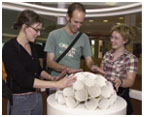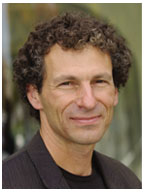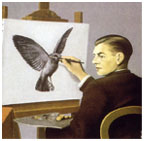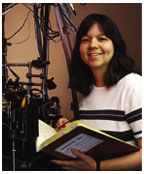November 5, 2003: Notebook

University task force recommends several changes to increase percentage of females on the faculty
By Annetta Miller
The University should institute a wide range of incentives — including affordable child care, automatic “tenure clock” extensions, and professional mentoring — to attract and retain women in the science and engineering departments. Those were the recommendations in a report recently released by the Task Force on the Status of Women Faculty in the Natural Sciences and Engineering.
Convened by President Tilghman, the 11-member group conducted a yearlong analysis before making its recommendations, which include allocating $10 million to recruit, hire, and retain women faculty in the sciences. While the University has made considerable progress on these fronts, said Tilghman, “the fact that we still need to prime the pump is very clear to me. This is not going to be a quick fix.”
Chaired by molecular biology professor Virginia Zakian, the task force conducted interviews with faculty members in 14 departments in the sciences and engineering, analyzing hiring records, salaries, tenure rates, the allocation of laboratory space and research funding, and general job satisfaction. While men and women science faculty generally earned comparable salaries and had similar tenure rates, the report found that fewer women than men reported a sense of collegiality, inclusion, and contentment with their positions.
Noting that such issues also are concerns in other departments, Tilghman announced the appointment of psychology professor Joan Girgus to the new post of special assistant to the dean of the faculty to address matters relating to gender equity. Girgus will work with Dean of the Faculty David Dobkin to develop a plan to improve the climate for women faculty and staff throughout the University.
Christine Stansell ’71, acting director of the Program in the study of Women and Gender, hailed the decision to develop a University-wide plan, and praised the task force’s report: “Never before have we had anything as comprehensive based on such precise data. This will provoke discussion and give women a safe space to speak out about subjects that are often too difficult and too prickly to broach with colleagues.”
The task force identified several key areas to be targeted for improvement: They include:
• Hiring: While several science and engineering departments had made impressive gains in hiring women, several showed no progress or had seen the percentage of women faculty decline. Only in ecology and evolutionary biology, and in psychology, did women make up more than 20 percent of the faculty. The percentage of women faculty in the molecular biology department has dropped from 30 percent to 19 percent in the past 10 years, and the department of operations research and financial engineering — formed in 1999 — still has no female faculty. Recommendations: Increase the pool of female applicants, increase the number of offers to women, and try to ensure that women who work at Princeton are happy to remain.
• Child care and housing: Some 55 percent of women (compared to 37 percent of men) who had preschool-age children reported that they had problems with daycare. Several men surveyed said that daycare problems had adversely affected the careers of their female colleagues and postdocs in their labs. Recommendations: Make child care available on a sliding payment scale and confine all University and department meetings to the hours between 9 a.m. and 5 p.m. Give faculty, postdoctoral fellows, and research and technical staff who are the primary care givers for small children preference for University housing and parking.
• Tenure: The University currently allows parents of newborns or newly adopted children to add an extra year to the time allowed for seeking tenure. But some respondents complained that such delays were detrimental to their careers, did not take into account the demands of older children, or were not respected by male faculty members. “During my pregnancy (my last year on the tenure clock) I was never given the option of an additional year,” one woman reported. “In fact, once I had the child, I was harassed by the chairman to return to work, which I did two weeks after my child was born.” One tenured male professor wrote “the perception [is] that the faculty member is trying to gain an unfair advantage by having more time to do research before the tenure decision.” Recommendations: Institute an automatic tenure extension for all assistant professors who become parents with the understanding that they could come up for tenure earlier if they so choose. Make it clear that tenure extensions do not change the threshold of accomplishment for tenure.
• Mentoring: While respondents felt that women with mentors generally had an easier time during the tenure process, the survey showed that only 33 percent of women — compared with 64 percent of men — reported having a mentor. A similar gender difference in mentoring was reported by former faculty. Recommendations: Make departmental and University mentoring policies more clear and equitable. Provide better mentoring for junior faculty.
“I hope people come away from this report understanding that the
University is committed to solving this problem,” Zakian said. “We
are going to move forward; it is not going to be business as usual.”
![]()
A copy of the task force’s report can be found at www.princeton.edu/paw.
Annetta Miller is a freelance writer in Princeton.

 You
can hear a Ping sing
You
can hear a Ping sing
Photo: frank wojciechowski
Do you hear what I hear? Visitors, including, from left, Ingrid Horrocks GS, Tim Corballis, and Tamara Witschge, “play” graduate student composer Ted Coffey and ceramist Rebekah Wostrel’s “Ping,” an interactive musical instrument. “Ping” was one of several installations in last month’s music department open house, which showcased new work.
“Ping” is a conglomerate of ceramic cones, each of which encloses
a light-sensitive photoresistor and produces a different sound. When the
light shifts around a cone, the tone and sound change. Another unusual
project, “Monument” by graduate student composer Betsey Biggs
and her collaborator at the University of California—Berkeley, was
a video of a collection of small rocks. From time to time, a rock would
shift and then spring from view, accompanied by music based on the sounds
a rock makes when striking another. A background drone was composed of
a variety of sounds, including locusts, drums, coyotes, cats, whistles,
and storms. ![]()

 Bringing
math to life
Bringing
math to life
Photo: Dan Rockmore ’84 (Joseph mehling)
Image below: One of the themes of Rockmore’s documentary, The Math Life, is how the problem-solving process for mathmaticians is like the creative process for visual artists — seeing what other people do not. (perspicacity (1936) by René Magritte c. 2002, C. Herscovici, Brussels, Artists Rights Society (ARS), New York, courtesy Galerie Isy Brachot, Brussels)
Quick, name a movie about math. If Good Will Hunting comes to mind, you’re like most people. But mathematician Dan Rockmore ’84 is emphatic: That film is not about math. Math is more than a janitor/genius solving a problem after hours; it’s also about beauty, humor, quirky thinkers, and exhilarating connections between the abstract and the real world.
A new documentary, The Math Life, created by Rockmore with filmmakers Wendy Conquest and Bob Drake, tries to capture all that by erasing math from the chalkboard and giving it life. The filmmakers visited mathematicians around the U.S. — several from Princeton — and asked them to talk about themselves and their relationships to math, including their first meaningful exposure to the field. Some tell of early negative experiences, but others speak with wonder of their introduction to math. Ingrid Daubechies, a Princeton professor of mathematics and applied and computational mathematics, tells of her father going around her house and asking her to measure every circle she could find, including the antique plates her mother collected.
The filmmakers wove the interviews with footage from outside the academy. For instance, during a segment about finding patterns in the random, the painter Jackson Pollack is seen hard at work; during a segment about synchrony, an audience in Austria claps in rhythm. Rockmore and his team also incorporated dynamic computer animation to illustrate difficult concepts, such as the fourth dimension.
 One
aim of the project was to introduce adolescents to math as a discipline
and show them it’s not all that scary. “The whole point of the
project was to show math’s accessibility and its applicability and
to interest younger viewers in the field and vocation of mathematics,”
says Rockmore.
One
aim of the project was to introduce adolescents to math as a discipline
and show them it’s not all that scary. “The whole point of the
project was to show math’s accessibility and its applicability and
to interest younger viewers in the field and vocation of mathematics,”
says Rockmore.
Cobbling together funding from the National Science Foundation, and Dartmouth College, where he is a professor of mathematics and computer science, Rockmore and his collaborators organized the 52-minute film into sections such as “Shape,” “Number,” and “The Real World.” A significant section was devoted to the Riemann Hypothesis, which involves finding a formula that accounts for the distribution of prime numbers, and which is an active area of research for several Princeton faculty.
The film’s “stars” are the mathematicians, including Princeton professor John Conway, who talks about games; Princeton’s Peter Sarnak, who discusses what it’s like to be “stuck” on a problem; Cornell professor Steven Strogatz ’80; and M.I.T. professor Arlie Petters *91.
The Math Life is distributed by Films for the Humanities and Sciences and has been shown on public television around the country, with future airings planned.
Rockmore’s next project, also funded by the N.S.F., will focus
on the new math of the life sciences, and he expects it to be out in two
years. ![]()
By L.O.

 Deborah
Jin ’90 (Photo: geoffrey wheeler), a physicist at the Commerce Department’s
National Institute of Standards and Technology in Boulder, Colorado, and
adjoint assistant professor of physics at the University of Colorado at
Boulder, received a $500,000 MacArthur Fellowship, known as the “genius
grant.” In 1999, Jin cocreated a new quantum gas that was named one
of the top 10 scientific advances of the year by the journal Science.
Deborah
Jin ’90 (Photo: geoffrey wheeler), a physicist at the Commerce Department’s
National Institute of Standards and Technology in Boulder, Colorado, and
adjoint assistant professor of physics at the University of Colorado at
Boulder, received a $500,000 MacArthur Fellowship, known as the “genius
grant.” In 1999, Jin cocreated a new quantum gas that was named one
of the top 10 scientific advances of the year by the journal Science.
President Tilghman has appointed a health care task force to answer several questions: How should Princeton meet the needs of its students for medical and mental health care, and to what extent should it also meet health care needs of members of its faculty and staff? What programs, services, and facilities should the University provide to promote the health and well-being of its students, faculty, and staff, including programs of preventive health, health maintenance, nutrition, recreation, and stress management? How can the University improve the balance between family and work, for example, by offering additional day-care and other family support services? The group hopes to complete a report in spring 2004.
The Department of Public Safety has posted the University’s annual campus security report at http://web.princeton.edu/sites/publicsafety/.
Carrie Gordon, director of Princeton-In-Asia, died September 27 of breast cancer. She was 48 and had been director of the program for 10 years. A Stanford anthropology graduate, she earned a master’s degree in international education from Columbia and was known for her frank manner, amusing stories, and a knack of making arduous working conditions sound like the chance of a lifetime. A memorial service will be held in the Princeton Chapel next year, but the date had not been decided by press time. For more information go to www.princeton. edu/~pia/.
Faculty awards: Three Princeton mathematicians have been honored recently:
Elliott Lieb was awarded the Henri Poincaré Prize by the International
Association of Mathematical Physics for his “lifetime achievements
in quantum mechanics, statistical mechanics, and analysis”; Weinan
E, was awarded the International Congress on Industrial and Applied Mathematics
Collatz Prize for 2003 (given to scientists under 42 years of age for
outstanding work on industrial and applied mathematics); and Martin Kruskal,
professor of mathematics and astrophysical sciences emeritus, was awarded
the Maxwell Prize for 2003 by the Institute of Mathematics and Its Applications.
In physics, associate professor Suzanne Staggs has been named the winner
of the Maria Goeppert-Mayer Award from the American Physical Society.
The award is intended to recognize outstanding achievement by a woman
physicist in the early years of her career. In astrophysical sciences,
John Bahcall, a visiting lecturer with rank of professor at Princeton,
has been named one of three winners of the Enrico Fermi Award. The presidential
honor recognizes scientists of international stature for exceptional achievement
over a lifetime in the development, use, or production of energy.
![]()
